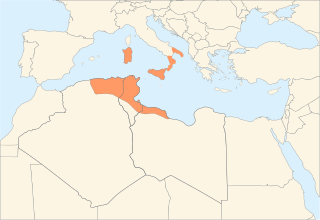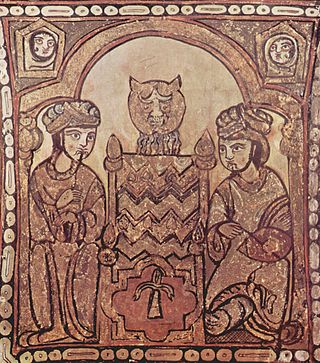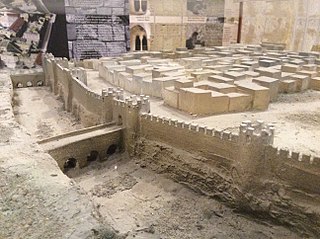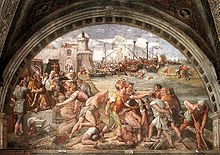
Year 849 (DCCCXLIX) was a common year starting on Tuesday of the Julian calendar.

Saracen was a term used both in Greek and Latin writings between the 5th and 15th centuries to refer to the people who lived in and near what was designated by the Romans as Arabia Petraea and Arabia Deserta. The term's meaning evolved during its history of usage. During the Early Middle Ages, the term came to be associated with the tribes of Arabia.

The Aghlabids were an Arab dynasty centered in Ifriqiya from 800 to 909 that conquered parts of Sicily, Southern Italy, and possibly Sardinia, nominally as vassals of the Abbasid Caliphate. The Aghlabids were from the Najdi tribe of Banu Tamim and adhered to the Mu'tazilite rationalist doctrine within Hanafi Sunni Islam, which they imposed as the state doctrine of Ifriqiya. They ruled until 909 when they were conquered by the new power of the Fatimids.

Islam is a minority religion in Italy. Muslim presence in Italy dates back to the 9th century, when Sicily came under control of the Aghlabid Dynasty. There was a large Muslim presence in Italy from 827 until the 12th century. The Norman conquest of Sicily led to a gradual decline of Islam, due to the conversions and emigration of Muslims toward Northern Africa. A small Muslim community however survived at least until 1300.

The Kalbids were a Muslim Arab dynasty in the Emirate of Sicily, which ruled from 948 to 1053. They were formally appointed by the Fatimids, but gained, progressively, de facto autonomous rule.

The Duchy of Naples began as a Byzantine province that was constituted in the seventh century, in the reduced coastal lands that the Lombards had not conquered during their invasion of Italy in the sixth century. It was governed by a military commander (dux), and rapidly became a de facto independent state, lasting more than five centuries during the Early and High Middle Ages. Naples remains a significant metropolitan city in present-day Italy.

The Emirate of Sicily or Fatimid Sicily was an Islamic kingdom that ruled the Muslim territories on the island of Sicily between 831 and 1091. Its capital was Palermo, which, during this period, became a major cultural and political center of the Muslim world.
The Arab raid against Rome took place in 846. Muslim raiders plundered the outskirts of the city of Rome, sacking the basilicas of Old St Peter's and St Paul's-Outside-the-Walls, but were prevented from entering the city itself by the Aurelian Walls.

Caesar the Brave was the admiral of the fleet of the Duchy of Naples during the reigns of his father, Sergius I, and brother, Gregory III.

The history of Islam in Sicily and southern Italy began with the first Arab settlement in Sicily, at Mazara, which was captured in 827. The subsequent rule of Sicily and Malta started in the 10th century. The Emirate of Sicily lasted from 831 until 1061, and controlled the whole island by 902. Though Sicily was the primary Muslim stronghold in Italy, some temporary footholds, the most substantial of which was the port city of Bari, were established on the mainland peninsula, especially in mainland southern Italy, though Muslim raids, mainly those of Muhammad I ibn al-Aghlab, reached as far north as Naples, Rome and the northern region of Piedmont. The Arab raids were part of a larger struggle for power in Italy and Europe, with Christian Byzantine, Frankish, Norman and local Italian forces also competing for control. Arabs were sometimes sought as allies by various Christian factions against other factions.

The Muslim conquest of Sicily began in June 827 and lasted until 902, when the last major Byzantine stronghold on the island, Taormina, fell. Isolated fortresses remained in Byzantine hands until 965, but the island was henceforth under Muslim rule until conquered in turn by the Normans in the 11th century.

The Norman conquest of southern Italy lasted from 999 to 1194, involving many battles and independent conquerors.
The Emirate of Bari was a short-lived Islamic state in Apulia, in what is now Italy, ruled by non-Arabs, probably Berbers and Black Africans. Controlled from the South Italian city of Bari, it was established about 847 when the region was taken from the Byzantine Empire, but fell in 871 to the army of the Carolingian emperor Louis II.

The Papal Navy was the maritime force of the Papal States. Loosely construed, it was in sporadic existence from approximately the Battle of Ostia (849) during the pontificate of Leo IV until the ascension of Pope Leo XIII in 1878.

The navy of the Fatimid Caliphate was one of the most developed early Muslim navies and a major force in the central and eastern Mediterranean in the 10th–12th centuries. As with the dynasty it served, its history is in two phases. The first was c. 909 to 969, when the Fatimids were based in Ifriqiya ; the second lasted until the end of the dynasty in 1171, when they were based in Egypt. During the first period, the navy was employed mainly against the Byzantine Empire in Sicily and southern Italy, where it enjoyed mixed success. It was also in the initially unsuccessful attempts to conquer Egypt from the Abbasids and brief clashes with the Umayyad Caliphate of Córdoba.

The Battle of Stelai was a naval battle fought in 880 between the Byzantine and Aghlabid fleets off the southern Italian peninsula. The battle was a major Byzantine victory. Its location is disputed, hence it is also known as the First Battle of Milazzo or the Battle of Punta Stilo in modern literature.

The Battle of the Straits was fought in early 965 between the fleets of the Byzantine Empire and the Fatimid Caliphate in the Straits of Messina. It resulted in a major Fatimid victory, and the final collapse of the attempt of Emperor Nikephoros II Phokas to recover Sicily from the Fatimids.

The siege of Melite was the capture of the Byzantine city of Melite by an invading Aghlabid army in 870 AD. The siege was initially led by Halaf al-Hādim, a renowned engineer, but he was killed and replaced by Sawāda Ibn Muḥammad. The city withstood the siege for some weeks or months, but it ultimately fell to the invaders, and its inhabitants were massacred and the city was sacked.

Malta was ruled by the Byzantine Empire, from the time of the Byzantine conquest of Sicily in 535-6 to 869-870, when the islands were occupied by Arabs. Evidence for the three centuries of Byzantine rule in Malta is very limited, and at times ambiguous. Historians theorise that Byzantine Malta was exposed to the same phenomena affecting the Central Mediterranean, namely a considerable influx of Greek settlers and Hellenic culture, administrative changes brought about by the reorganisation of Sicily along the lines of a Byzantine theme, and significant naval activity in the Mediterranean following the rise of Islam.

The siege of Taormina in 902 ended the conquest of the Byzantine city of Taormina, in northeastern Sicily, by the Aghlabids. The campaign was led by the deposed Aghlabid emir, Ibrahim II, as a form of armed pilgrimage and holy war. Ibrahim's forces defeated the Byzantine garrison in a hard-fought battle in front of the city walls, and laid siege to the city. Left unsupported by the Byzantine government, Taormina capitulated on 1 August. The population was massacred or sold into slavery. The fall of this last major Byzantine stronghold signalled the completion of the Muslim conquest of Sicily, which had been ongoing since the 820s, although some minor Byzantine outposts survived until the 960s.
















